
Published Version 2 on July 25th, 2024.
Oracle Fusion Analytics (Fusion Analytics) is a component of the Oracle Fusion Data Intelligence (FDI) platform designed to deliver personalized insights for Oracle Fusion Cloud Applications (Fusion Cloud Applications). It combines business data, ready-to-use analytics, and prebuilt AI and machine learning (ML) models to deliver deep insights and actionable results.
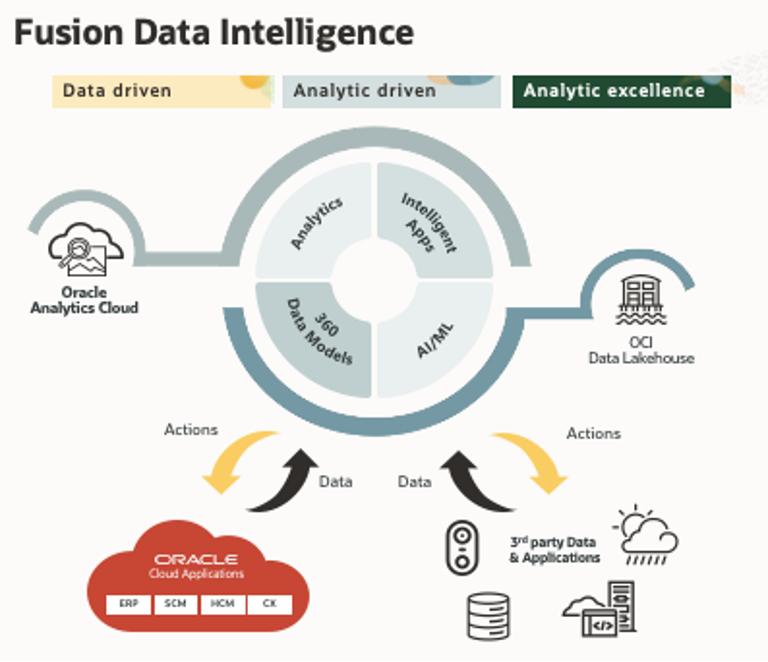
This post builds upon the foundation described in Use Custom Hostnames for Oracle Fusion Analytics.
It guides setting up the OCI (Oracle Cloud Infrastructure) network components required to use custom hostnames to access Fusion Analytics services privately through VPN and FastConnect. Architectural diagrams, component descriptions, access flows, and links for additional references are included.
Note: This post describes using a custom hostname for two FDI web services, one of which is OAC (Oracle Analytics Cloud). It does not cover using a custom hostname for the FDI ADW (Autonomous Data Warehouse). The Call to Action includes links to relevant ADW documentation.
Note: The Vanity URL feature available in standalone instances of OAC offers more functionality than the method described in this post. However, it is unavailable in the current release of Fusion Analytics. The method described in this post may also be used for standalone instances of OAC if desired.
Use Case
Custom hostnames enable customers to use their registered domains for Fusion Analytics services and a single hostname for multiple web services.
The following shows the Fusion Analytics prebuilt hostnames format as of the current release.
- Fusion Analytics Console
- <instance name>-<tenancy name>-prod.data.analyticsapps.<region name>.ocs.oraclecloud.com
- Oracle Analytics Cloud
- oax<instance name>-<tenancy object storage namespace>-to.analytics.ocp.oraclecloud.com
The following shows an example format of a custom hostname used by Myorg, inc., whose registered domain is myorg.com.
- For all Fusion Analytics services
- analytics.<environment>.myorg.com
Prerequisites
Following the guidance in this post requires:
- Fusion Analytics Components
- An accessible Fusion Analytics environment using default Fusion Analytics hostnames.
- Custom hostname components described in Use Custom Hostnames for Oracle Fusion Analytics:
- The custom hostname designated for the Fusion Analytics environment.
- The certificate for the hostname signed by a CA (Certificate Authority).
- Privileges to
- Manage load-balancers, certificate-authority-family, and virtual-network-family in the compartment hosting the Fusion Analytics environment.
- Create, register, and publish DNS entries for the custom hostnames.

The architecture diagrams depict the initial and prepared states.
Initial State
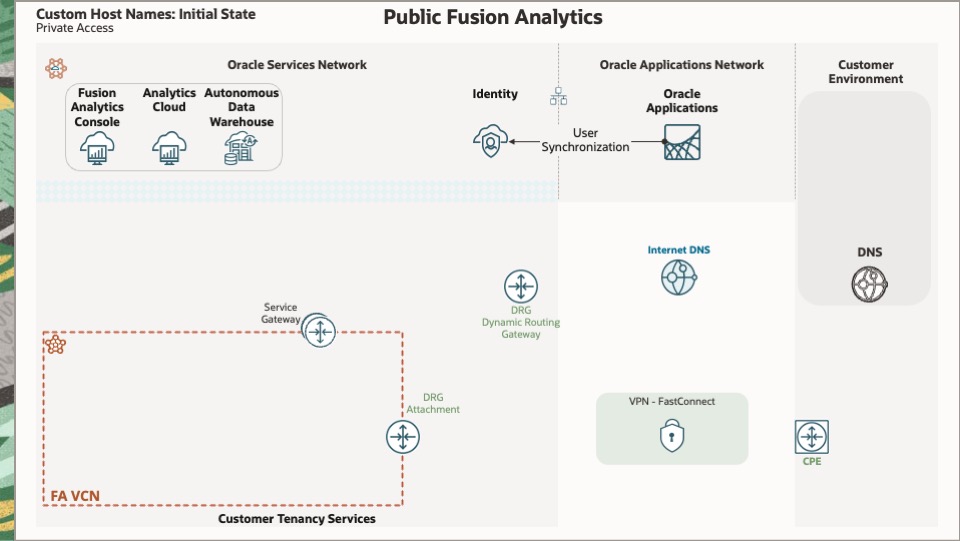
This diagram depicts the initial state of a public Fusion Analytics instance.
Prepared State
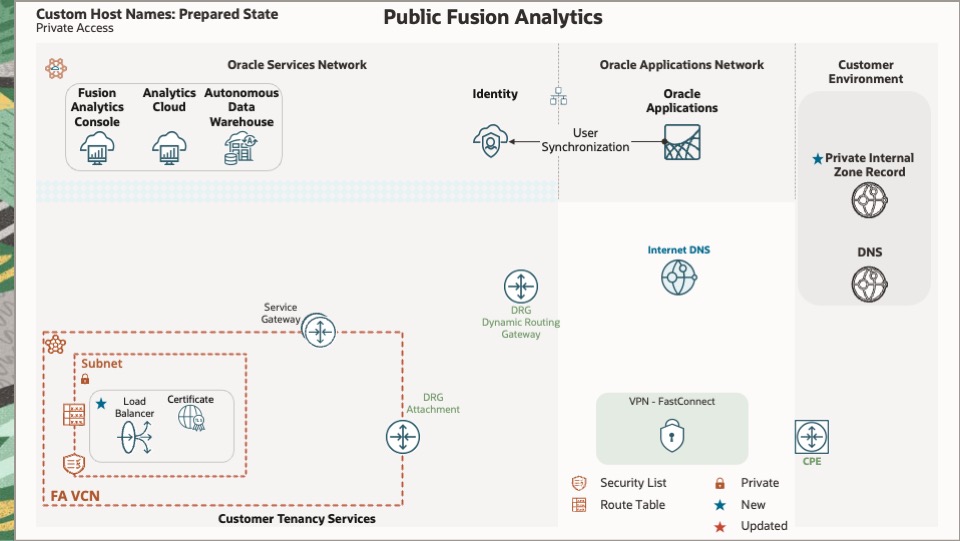
This diagram depicts the prepared state of a public Fusion Analytics instance using custom hostnames.

This section describes the additional and updated components in the prepared-state architecture diagram.
The OCI Certificates Service creates and manages TLS certificates, certificate authorities (CAs), and CA bundles. It provides certificate issuance, storage, revocation, and automatic renewal capabilities.
In the prepared environment, the Certificates service stores the certificate associated with the custom hostname.
Private Load Balancer
A load balancer provides automated traffic distribution and processing from a single entry point.
A private load balancer has a private IP address inaccessible from the Internet and can be associated with a friendly DNS name through any DNS vendor.
In the prepared diagram, a private load balancer receives a Fusion Analytics URL containing a custom hostname and returns the prebuilt Fusion Analytics URL. Its private IP address is associated in DNS with the custom hostname.
A rule set is associated with the load balancer’s listener and comprises rules and actions applied to inbound traffic.
A URL redirect rule specifies the path string and match condition the service uses to evaluate an incoming URL. URL redirect rules specify how to redirect incoming URLs to destination URLs. A destination URL and response code are returned to the client.
Load Balancer Backend Set
A backend set is a logical entity associated with the load balancer listener. It is defined by a load balancing policy, a health check policy, and, optionally, a list of backend servers.
In the prepared environment, the default backend set is defined without backend servers, as they are unnecessary for URL redirection.
Load Balancer Listener
A listener is a logical entity that checks for incoming traffic on the load balancer’s IP address. For FDI and OAC URL redirection, it handles HTTPS traffic arriving on port 443.
In the prepared environment, it is configured with the following:
- SSL termination using the custom hostname certificate managed by the Certificates service.
- The rule set defined for URL redirection.
Customer DNS
The customer DNS is modified to add records to a private internal zone.
Note: Optionally, a public external zone can be used.
A DNS “A” record is added to a private internal zone. It contains the load balancer’s custom hostname and the private IP address of the load balancer.

Several frameworks exist to deploy the components:
The Call to Action includes links to documentation for using the OCI console.
A typical provisioning sequence follows:
- Import the custom hostname certificate determined in Use Custom Hostnames for Oracle Fusion Analytics to the OCI Certificates Service.
- Create a private load balancer with a private IP address in a private subnet.
- Accept the defaults for the backend set. Do not add backend servers.
- Configure the listener for the HTTPs protocol and port 443.
- Configure SSL for the listener using the custom hostname certificate.
- Update the load balancer.
- Create and associate a Rule Set to the load balancer listener.
- Add URL redirection rules for these source paths to the rule set.:
- /ui
- /ui/dv
- /analytics
- /ui/analytics
- /ui/oax
- For each rule:
- Use the prebuilt FDI console hostname for the /ui/oax rule.
- Use the prebuilt FDI OAC hostname for all other rules.
- Use the source path as the Path.
- Use Force longest prefix match as the Match type.
- Use https as the Redirect protocol.
- Use 443 as the Redirect port.
- Leave the Redirect query blank.
- Use 301 - Moved Permanently as the Response code.
- Add URL redirection rules for these source paths to the rule set.:
- Create and associate a Rule Set to the load balancer listener.
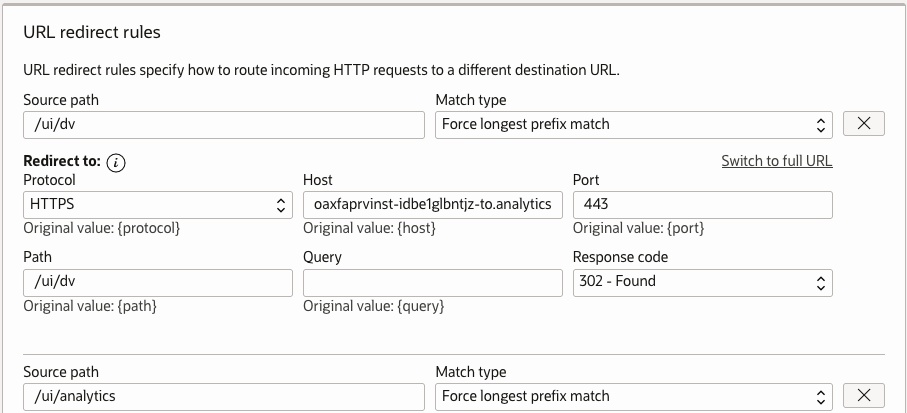
- Follow your organization’s procedures for adding a DNS record to the private internal zone containing the custom hostname and the load balancer’s private IP address.
An example may look like this:
Domain:
Type:
TTL:
RDATA:
analytics.dev.myorg.com
A
500
10.35.20.68

After the components are deployed, custom hostnames can be used to access Fusion Analytics services.
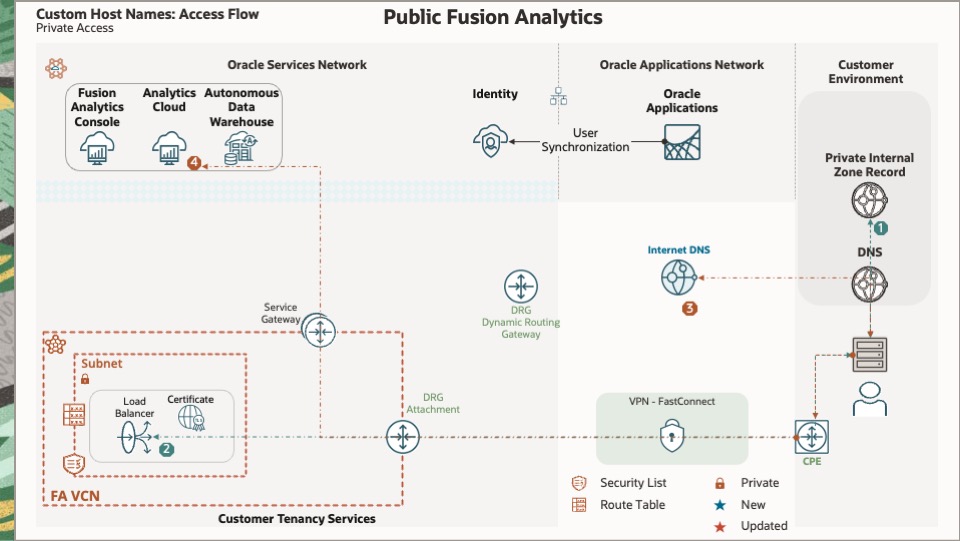
This diagram depicts the access flow for a public Fusion Analytics instance using custom hostnames.
![]()
![]()
![]()
![]()
A client browser sends a DNS query with the Fusion Analytics custom hostname. The query is resolved with the record in the private internal zone, and the LB (Load Balancer) IP is returned.
The browser sends an HTTPs request to the LB with the Fusion Analytics custom hostname in the URL. The LB evaluates the URL path and match rules and returns the prebuilt Fusion Analytics hostname in the URL.
The browser sends a DNS query with the prebuilt Fusion Analytics hostname. An Internet DNS resolves the query, and the Fusion Analytics service IP is returned.
The browser sends an HTTPs request with the Fusion Analytics hostname in the URL to the Fusion Analytics web service.


